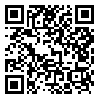BibTeX | RIS | EndNote | Medlars | ProCite | Reference Manager | RefWorks
Send citation to:
URL: http://tumj.tums.ac.ir/article-1-1134-en.html
Background: Cephalometry is one of the important branches of anthropometry that has wide uses in identification, forensic medicine, plastic surgery, orthodontics, archeology and determining the origins of races. This research was investigated to determine the head and face phenotypes among one-day newborn boys in two aborigines of Sistani and Baluchi who were resident in Zahedan.
Materials and Methods: The investigation is based on cross-sectional analytical descriptions of 420 newborn aborigine boys (216 Sistani & 204 Baluchi), who were clinically healthy, in Quds hospital in summer 1381, in Zahedan. In this study cephalic and prosopic indices were determined by classical cephalometric.
Results: The mean and the standard deviations of cephalic index were 83.67±4.80 and 83.64±4.77 and prosopic index 86.79±5.87 and 86.53±6.76 for Sistani and Baluchi subjects respectively. Based on the cephalic index, the dominant head types in sistani group were hyperbrachycephalic (37%) and brachycephalic (37%). In Blachui group, the hyperbrachycephalic (37.3%) and brachycephalic (35.3%) type were the dominant one. Furthermore, according to the prosopic index. The dominant face type among sistanis was euryprosopic type (42.6%). In Baluchi group, the dominant face type was also euryprosopic (39.2%).
Conclusion: This research showed no statistically significant differences in terms of head and face type indices between two aborigines of Zahedan. Based on this cross-sectional study, it seems that there is similarities between the aforementioned groups
| Rights and permissions | |
 |
This work is licensed under a Creative Commons Attribution-NonCommercial 4.0 International License. |





